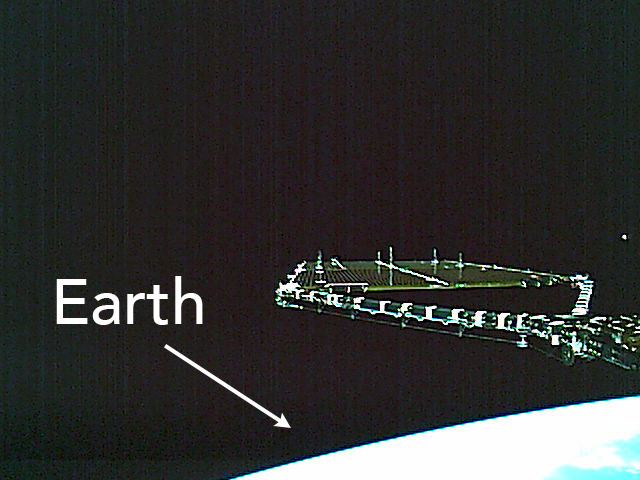Topics List
Feb. 18, 2020 Updated
Massive bushfires in Australia seen from Space
|
Australia has naturally faced many droughts and bushfires, but conditions have been unusually severe this time. Sometime around September 2019, the bushfires continuously occurred around the state of New South Wales in southeast Australia. The fires had been spreading on a larger scale, and a number of massive fires had merged into a "Mega Fire" that was out of control. The fires are unlikely to end entirely even at the end of January 2020. 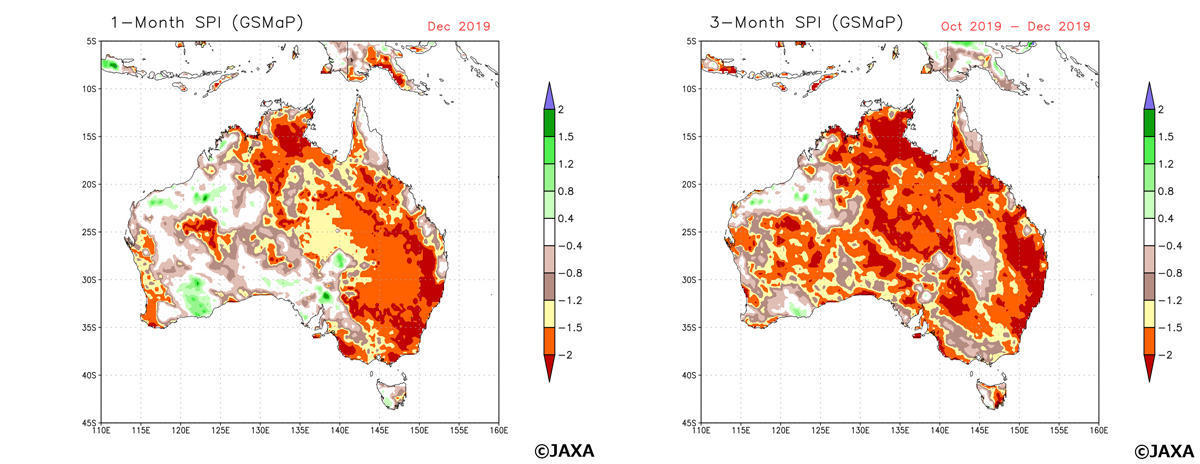
Figure 1 (left) Standardized Precipitation Index (SPI) in Australia calculated by GSMaP precipitation amount in a month (December 2019), (right)SPI calculated by GSMaP precipitation amount in three months (October-December 2019) in a same way. The relations between SPI value, the range of drought and frequency of phenomenon were classified by WMO (2012). In case SPI value becomes "-1.5 to -1.99", it indicates the situation of "Severe dryness" which happens "once in 20 years". In case SPI value becomes less than -2.0, it corresponds "Extreme dryness" which happens "once in 50 years". These condition shows the possibility of severe drought occurrence which leads to a big social impact. |
Mar. 1, 2019 Updated
New Dataset Release: GCOM-C/SGLI
|
JAXA GCOM-C (Global Change Observation Mission - Climate "SHIKISAI") satellite was launched on Dec. 23rd, 2017 to conduct long-term and continuous global observations in order to elucidate the global warming mechanisms related to fluctuations in radiation budget and/or carbon cycles etc. The released products can be downloaded via JAXA G-Portal ( https://gportal.jaxa.jp/ ) 1. Events after the launch
The data was released as scheduled according to the following operations. 2. The overview of Initial calibration and validation operations
To detect tiny climate change signals, higher accuracy products are needed. JAXA performed calibration with GCOM-C function using solar light, internal lamps, black body, lunar light and others, and compared (calibration and validation) GCOM-C observation value with ground observation data acquired in cooperation with ground observation networks (Skynet, AERONET and AsiaFlux) and collaborating research institutes (universities, Meteorological Research Institute, JAMSTEC and NOAA). As a result of the calibration, JAXA confirmed that the accuracy of 29 types of products covering land, atmosphere, ocean and cryosphere is attained to start data utilization. 3. GCOM-C/SGCLI Standard Products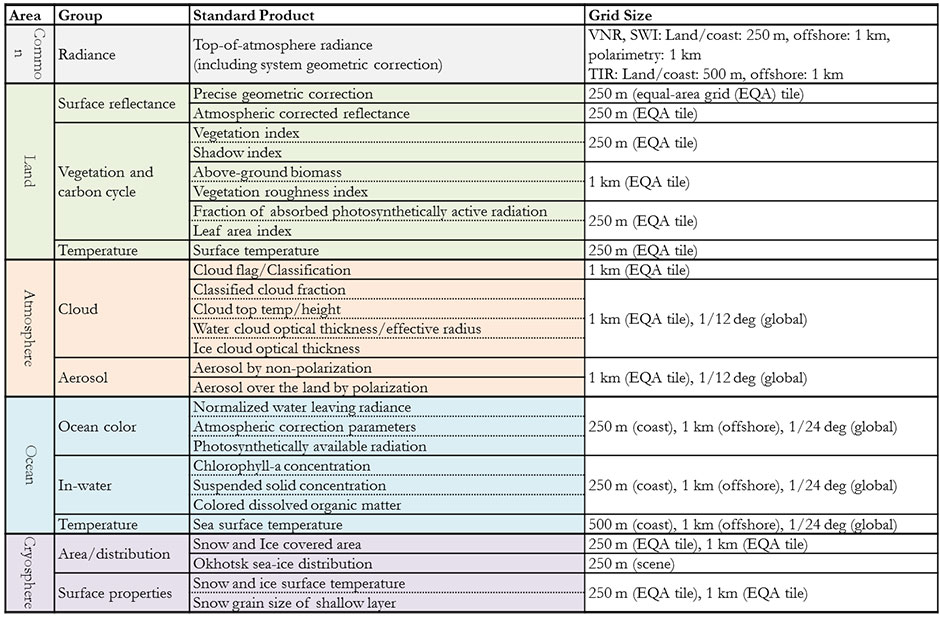
Further information for the definition of the product and sample data is available at; 1) Chlorophyll-a Concentration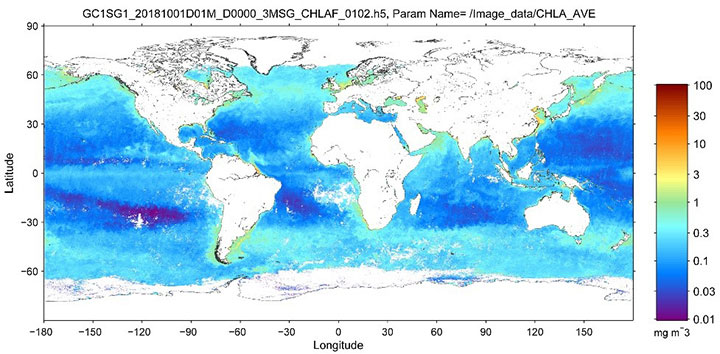
Global chlorophyll-a concentration (average of October 2018) 2) Aerosols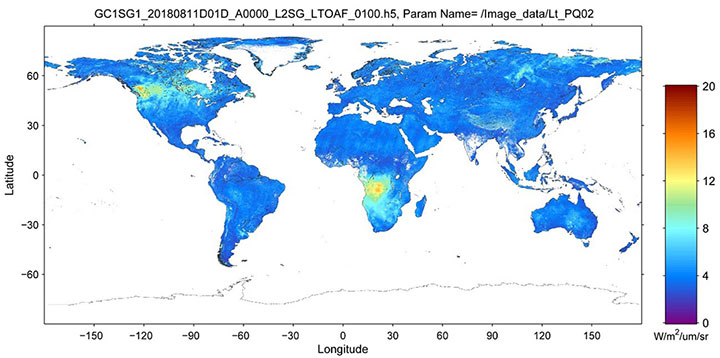
Polarization radiance at 867nm (average from August 11 to 20, 2018) 3) Global vegetation index (NDVI)The image is a map of global normalized difference vegetation index (NDVI) derived from SGLI observation data acquired during January 1st to 9th 2018. NDVI becomes high at active vegetation with high density, indicating the spatial distribution of vegetation on the global scale. 
|
Oct. 15, 2018 Updated
Sample Data of GCOM-C Standard Product Available on G-Portal
|
Launched on December 23, 2017 from the JAXA Tanegashima Space Center, Global Change Observation Mission – Climate (GCOM-C) entered and completed its in-orbit checkout phase, during which the science instruments and satellite systems are evaluated. The in-orbit checkout mission was through by March 2018, ensuring the product verification. |
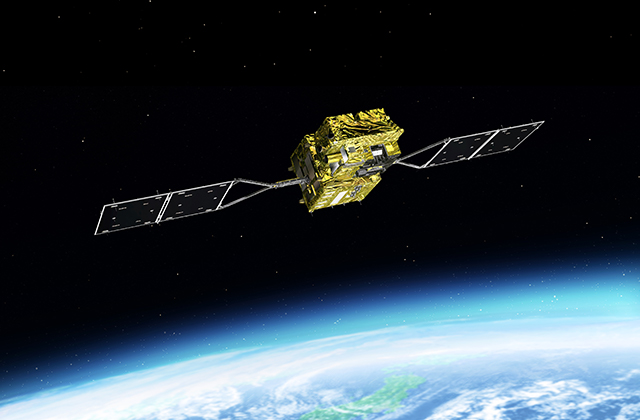
|
|---|
Jul. 3, 2018 Updated
Introduction to Polarization observation and Near Ultraviolet observation by SGLI
|
The Second Generation Global Imager (SGLI) instrument aboard the JAXA satellite Global Change Observation Mission-Climate (GCOM-C) is an optical sensor capable of observations at wavelengths ranging from near ultraviolet to thermal infrared (380nm to 12µm). SGLI can observe the polarization state of light in red and near infrared band by switching to directional angles from +45deg (forward) and -45deg (backward). Polarization measurement can provide the properties of light including the oscillation direction of electromagnetic waves, in addition to the magnitude of light.
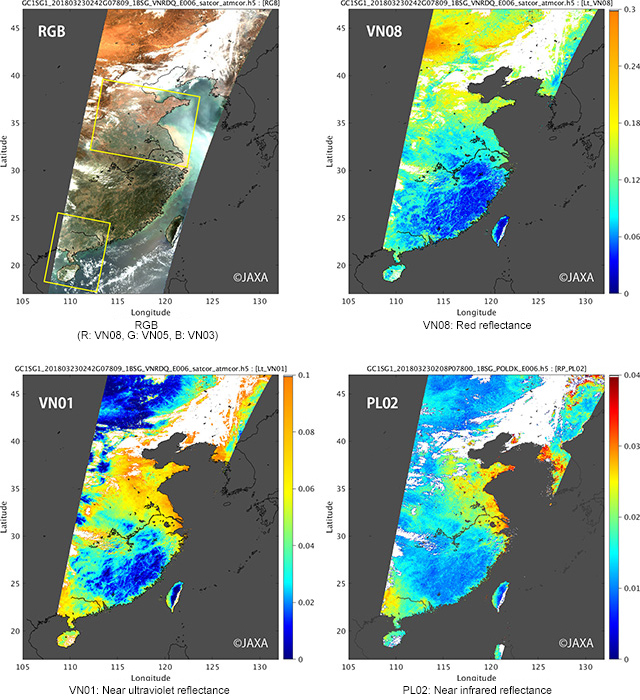
Images: |
Jan. 12, 2018 Updated
SHIKISAI Observation Data Acquired by SGLI
|
JAXA has released some observation images on the Earth acquired by the Global Change Observation Mission - Climate "SHIKISAI" (GCOM-C). The SHIKISAI was launched from the Tanegashima Space Center at 10:26:22 on December 23, 2017 (Japan Standard Time). These images are obtained by using the test radio wave transmitted from GCOM-C/SGLI on January 1st to 6th, 2018 (JST). |
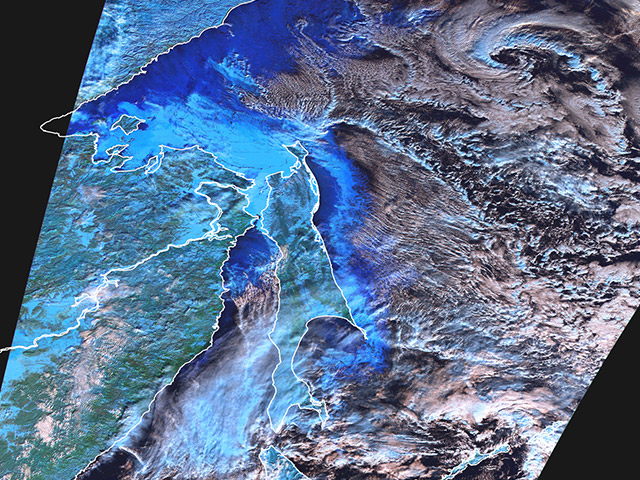
|
|---|
Dec. 24, 2017 Updated
SHIKISAI and TSUBAME critical operation phase successfully completed! Initial function verification starts!
|
JAXA received telemetry data from SHIKISAI and TSUBAME, confirming that their satellite attitude control system had transitioned to the steady state. Current status of both satellites is stable. |
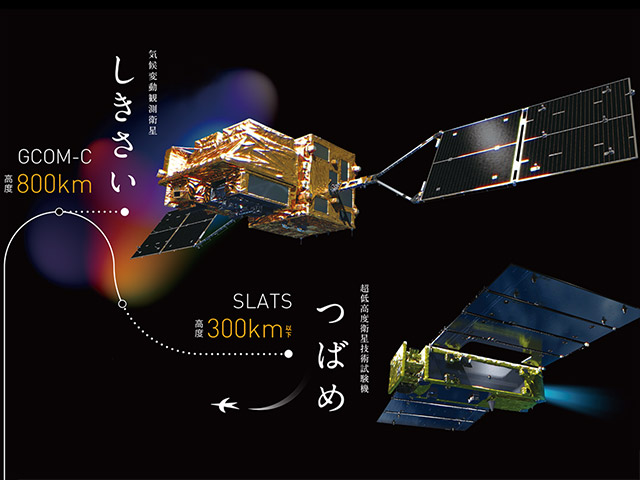
|
|---|
Dec. 23, 2017 Updated
SHIKISAI Solar Array Deployment – Images
|
The reception of telemetry data from JAXA's SHIKISAI satellite was made at 10:44 a.m. at the JAXA Mingenew Station, Australia, confirming SHIKISAI’s solar array deployment above Australia. Images Captured by the SHIKISAI onboard Cameras Following Solar Array Deployment
SHIKISAI Solar Arrays before Deployment in Computer Graphics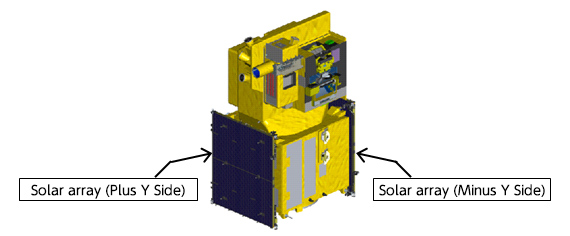
Image – Viewing Angle of SHIKISAI onboard Cameras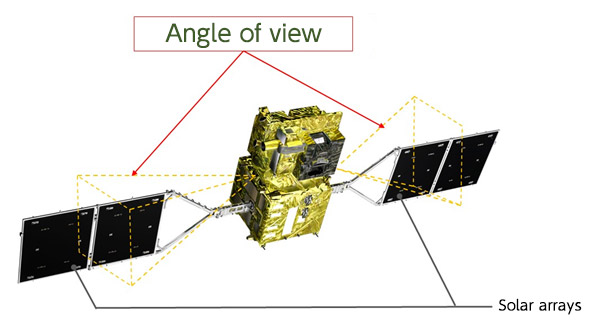
|

|
|---|
Dec. 23, 2017 Updated
Successful Launch, H-IIA Launch Vehicle No. 37 Encapsulating SHIKISAI and TSUBAME
|
The H-IIA Launch Vehicle No. 37 with the Global Change Observation Mission - Climate "SHIKISAI" (GCOM-C) and the Super Low Altitude Test Satellite "TSUBAME" (SLATS) onboard lifted off at 10:26:22 a.m. on December 23, 2017 (Japan Standard Time) from the Tanegashima Space Center. |
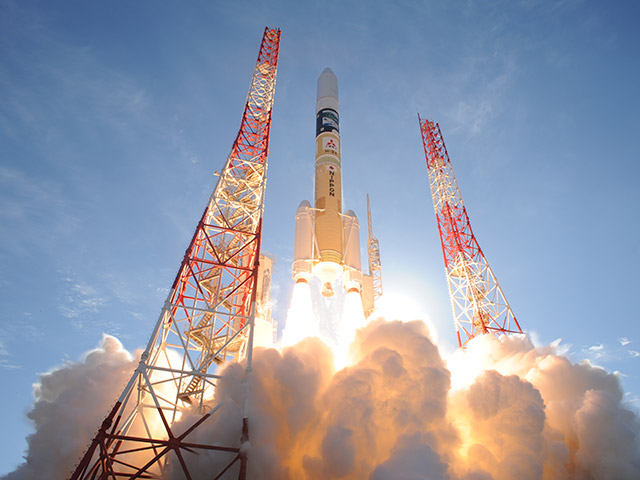
|
|---|
Oct. 27, 2017 Updated
H-IIA F37 with SHIKISAI/TSUBAME onboard to be launched on December 23
|
The launch schedule of the H-IIA Launch Vehicle No. 37 (H-IIA F37) has been decided to be between 10:26:22 thru 10:48:22 a.m. on December 23 (Sat), 2017 (Japan Standard time). The launch will be performed by Mitsubishi Heavy Industries and JAXA. |
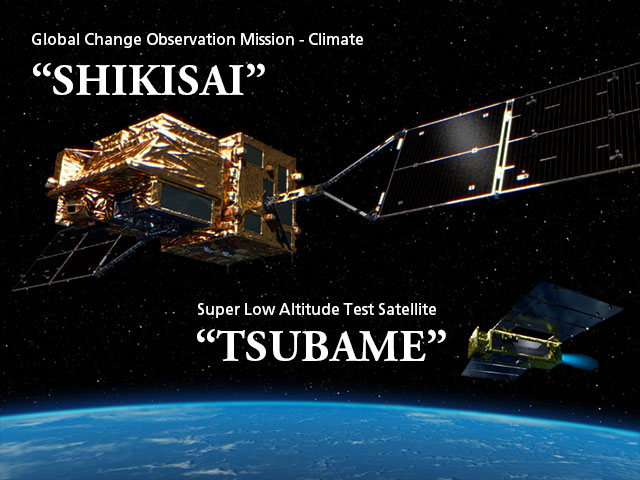
|
|---|
Jul. 14, 2017 Updated
GCOM-C renamed SHIKISAI
|
JAXA had the public come up with an excellent nickname for the Global Change Observation Mission – Climate (GCOM-C) for almost a month. The GCOM-C nickname project was couple with SLAT’s. The project was met with quite a response – 12,895 applications. As a result of careful examination, SHIKISAI, meaning colors in Japanese was chosen. |

|
|---|
May 26, 2017 Updated
GCOM-C Completes Environmental Testing
|
JAXA’s GCOM-C satellite, Global Change Observation Mission – Climate, to be launched in Japanese fiscal 2017, undergoes environmental testing at the JAXA Tsukuba Space Center. Environmental Test flow includes sinusoidal vibration and acoustics, which JAXA collectively calls mechanical and environmental testing. The testing, which aims at ensuring that the satellite will endure rigorous shock and sound pressure during ascent, was conducted in March and April, 2017 (Image) and came to successful completion. GCOM-C is entering electrical testing, which will determine if the satellite systems, after being subjected to environmental testing, operate properly. |
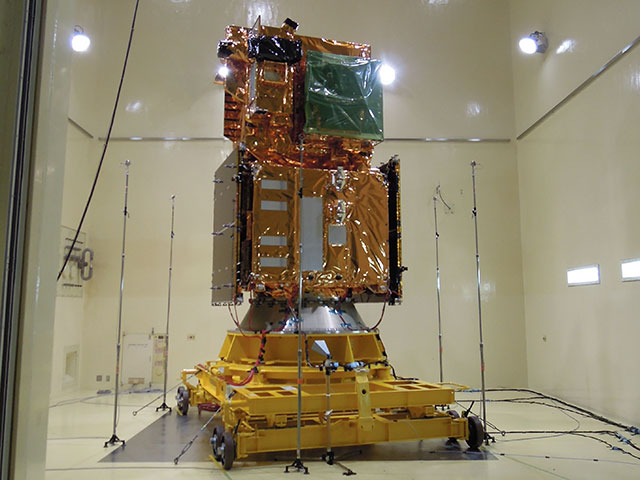
|
|---|
Dec. 26, 2014 Updated
Global Change Observation Mission – Climate (GCOM-C) mission logo
|
A mission logo for the Global Change Observation Mission – Climate
(GCOM-C) has been selected. GCOM-C is a satellite mission to clarify the climate change mechanism such as global warming, as well as to monitor the status of flying yellow sand, and to observe ocean plankton to estimate fishing points by acquiring various data on the Earth that is considered to have an impact on climate change.
|

|
|---|
Jul. 11, 2011 Updated
GCOM-C1 structural model sinusoidal vibration test
|
JAXA conducted a sinusoidal vibration test for the GCOM-C1 using a structural model. This test using simulated vibrations verifies if the satellite’s structure and onboard equipment can bear sinusoidal vibrations, which are generated at the time of launch. The test was successful, and we confirmed that the satellite is strong enough. The structural model is a mechanically mocked satellite for verifying the tolerance of the satellite’s main body and onboard equipment not only against sinusoidal vibrations at the time of launch, but also against other factors including the acoustic environment, shock at the time of separation from the launch vehicle, and impact of the solar array paddle deployment. |

|
|---|
Mar. 10, 2010 Updated
Symposium of "Expectations to the Climate Change Monitoring using Earth Observation Satellites"
|
The Japan Aerospace Exploration Agency (JAXA) is holding a symposium titled "Expectations for Climate Change Monitoring using Earth Observation Satellites" on April 15, (Thursday) 2010, at the Hotel Pacific Tokyo. |
 |
|---|
Jan. 9, 2010 Updated
Global Change Observation Mission 2nd Research Announcement
As the second Global Change Observation Mission (GCOM) research announcements (RA), the Japan Aerospace Exploration Agency (JAXA) announces the opportunity to conduct "development of retrieval algorithms for geophysical products", "fundamental data acquisition and validation preparation", and "application research directly connecting to the GCOM-C1 data".

